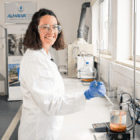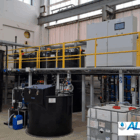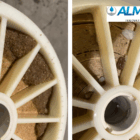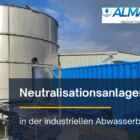Light liquid separators, also known as oil separators or coalescence separators, are essential system components in industrial wastewater treatment. They are used to separate light liquids such as mineral oils, petrol or other organic liquids that are immiscible with water from wastewater. Their use is particularly important in industries with wastewater containing oil or grease in order to prevent environmental pollution and comply with legal discharge limits.
Table of contents
Technological basics
Functional principle
Light liquid separators are based on the physical principle of density difference. As light liquids such as oils or fuels have a lower density than water, they rise to the surface while heavier particles sediment.
- Phase separation: Separation of water and light liquids by gravity.
- Sedimentation: Separation of heavy suspended solids and sediments.
- Coalescence: Finely dispersed oil droplets combine to form larger droplets that rise more quickly.
The separation takes place in three main stages:
- Calming zone: Reduction of the flow velocity so that oil droplets can rise and sediments can sink.
- Coalescence stage: Use of special inserts to combine small oil droplets into larger droplets.
- Drainage zone: discharge of purified water and retention of light liquids.
Structure of a light liquid separator
1. inlet zone
The wastewater enters the inlet zone, where the flow velocity is reduced. A distributor ensures an even flow through the system.
2. sedimentation zone
Heavier suspended solids settle in this zone. A sludge collection area at the bottom of the separator is used for regular disposal of the sediment.
3. coalescing unit
The coalescence stage consists of special filter media or lamellas that promote the aggregation of fine oil droplets. This improves the separation performance for finely dispersed light liquids.
4. light liquid collection area
Light liquids collect on the surface and are temporarily stored in a separate container. This area is often equipped with a float outlet to facilitate the drainage of light liquids.
5. drainage zone
The pre-cleaned water is fed through the outlet to the next treatment stage. In modern systems, a sampling shaft can be integrated to monitor the water quality.

Photo: Above-ground light liquid separator as an upstream treatment stage for the ALMA NeoDAF flotation system
Areas of application
Light liquid separators are indispensable in a variety of industries, including:
Petrochemical industry
- Treatment of oily wastewater from refineries and tank farms.
- Prevent fuels or mineral oils from entering the public wastewater network.
Workshops and automotive businesses
- Separation of oils and fuels from waste water from car washes or maintenance areas.
- Ensuring compliance with legal discharge limits.
Food industry
- Separation of animal and vegetable fats that occur in production processes.
- Reduction of oil and grease loads before biological treatment stages.
Rainwater treatment
- Used for contaminated rainwater drained from traffic areas or industrial plants.
- Protection of surface waters from pollution.
Standards and regulations
Light liquid separators are subject to strict technical standards and legal requirements. Important standards are
- DIN EN 858: Regulates requirements for construction, operation and maintenance.
- Water Resources Act (WHG): Requirements for the prevention of water pollution.
- Discharge limits: Local authorities set specific concentration limits for oils and fats.
Efficiency and limits
Advantages:
- Effective removal of light liquids and sediments.
- Protection of downstream treatment stages and reduction of environmental pollution.
- Easy maintenance and high operational reliability.
Limits:
- Insufficient for emulsified oils or chemically bound pollutants.
- Regular cleaning and disposal of sediments and light liquids required.
- Begrenzte Abscheideleistung bei sehr feinen Öltröpfchen (<20 µm).
Optimization potential
Combination with other treatment stages
To improve separation performance, light liquid separators can be combined with flotation systems.
Automation
Modern light liquid separators can be equipped with sensors that continuously monitor the fill level of the light liquids and the degree of contamination of the coalescence unit.
Conclusion
Light liquid separators are essential technologies in water and wastewater treatment, especially in industries with wastewater containing oil and grease. They offer an effective solution for complying with legal regulations and protecting water bodies. Efficiency and operational safety can be further increased by combining them with downstream treatment processes such as flotation systems and integrating modern monitoring systems.
For further information on our products, please feel free to contact us at any time!








